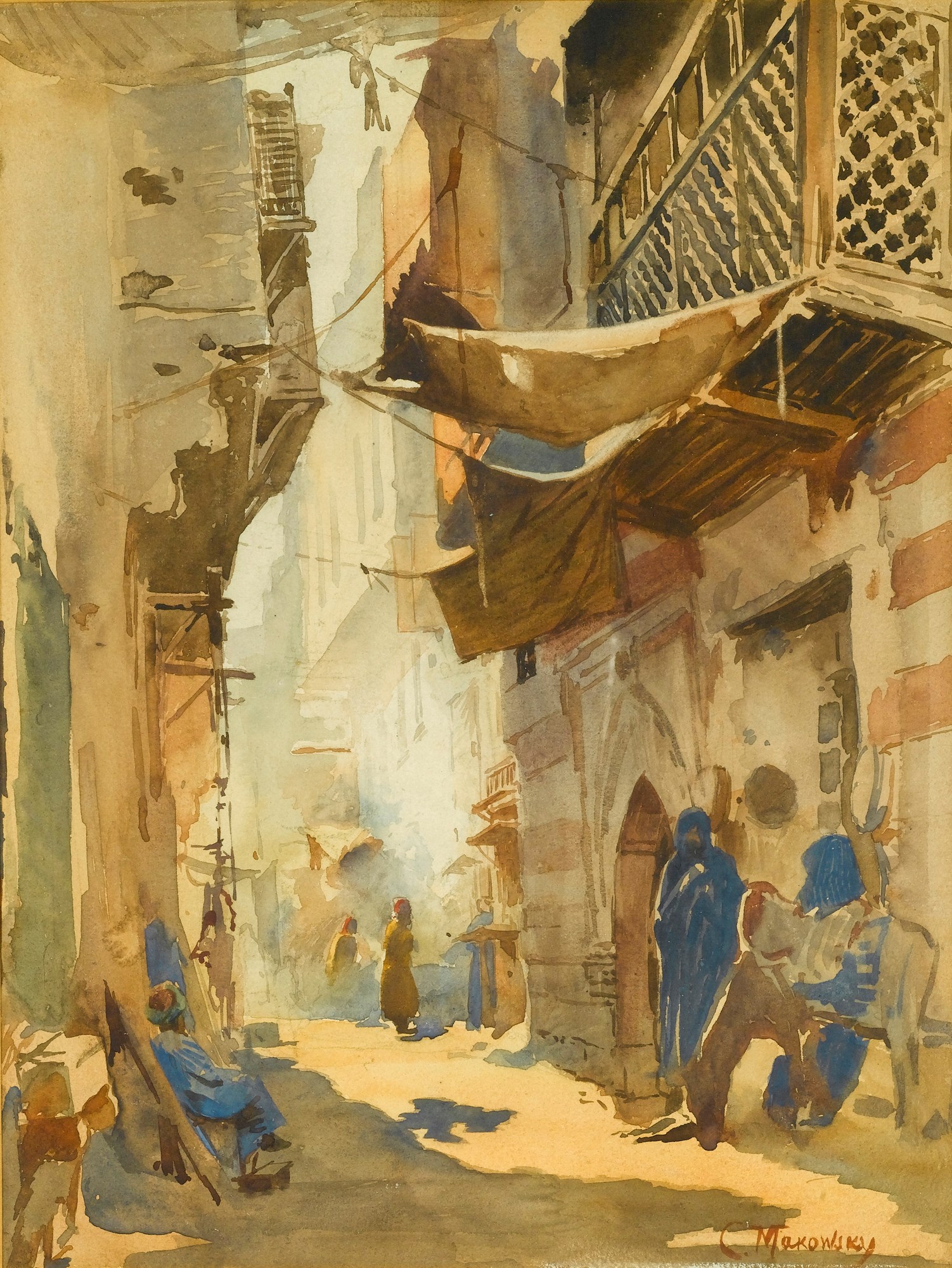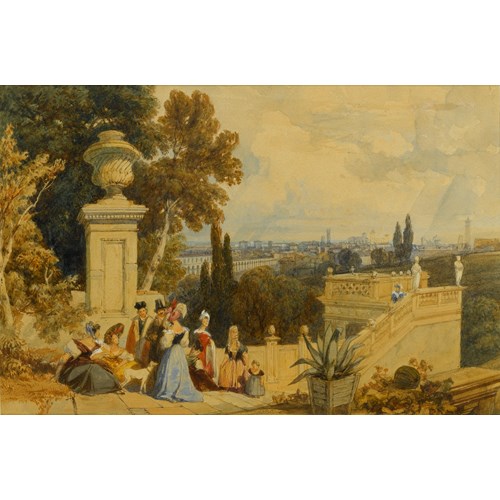Marketplace
A Study for ‘A Street Scene in Cairo’
Konstantin Egorovich Makovsky
A Study for ‘A Street Scene in Cairo’
Epoque 1850-1900, 19th century, 20th century
Origine Russia
Medium Watercolour on paper
Dimension 29.5 x 22 cm (11⁵/₈ x 8⁵/₈ inches)
The present watercolour is a study for Konstantin Egorovich Makovsky’s A Street in Cairo, which hangs in the State Russian Museum, St. Petersburg. There is an enigmatic atmosphere in the narrow, shadowy backstreet in Cairo. A creeping haze of dense smoke rises in the background filling the surrounding air. Makovsky leads the viewer not only to witness the activity taking place, but also to imagine the sounds and smells that emanate from the dusty, cramped street. On the right-hand side, two ladies wearing blue hijabs stand by a doorway talking, while a donkey rests nearby. On the left, a seated man wearing a blue full-length shirt or gallibaya and turban wound around a tarbush (fez) watches the street activity.
In the background, the high ledge of a wooden kiosk is visible. It is possible that the booth represents a local food stall, and the smoke from the cooking taking place within and alongside. Two men wearing dark yellow gallibaya stand nearby wearing red tarbush. After adopting the tarbush in the 1820s, making it part of the military uniform, Egypt became a major manufacturer and distributor in the Middle East. However the wearing of a tarbush was banned in 1952, after the Egyptian Revolution, as a symbol of independence from Ottoman influences.
The tightly packed buildings on either side of the narrow street are linked by ropes holding squares of material, presumably to cast shade on the ground below. The intensity of the sun is evident in the striking contrast between the dark areas of shadow and direct sunlight that fall on pavement. On the right hand building, an ornate wooden balcony juts out from the first floor and small, repeated Arabesque designs are cut into the wood. Known as Mashrafeya these delicate and ornate screens are typical of Islamic architecture, and some of the best examples are found in Old Cairo. The small holes reduced the amount of light coming into the house, which not only kept the rooms cooler but also had a second, social function that allowed women to observe the activities in the street, whilst retaining complete privacy.
There are two major differences between the study and the Russian Museum’s finished work. The first is the composition of figures on the right-hand side, where the donkey has been replaced by a man and a child. Secondly whereas the study is almost overwhelmingly bright, conveying the hot dusty atmosphere of Cairo, the oil makes a greater use of contrasts between light and shadow. This gives the work a slightly calmer feel, and is possibly not as atmospheric as Makovsky’s study.
Makovsky trained at both the Moscow School of Painting from 1851 to 1858 and the St. Petersburg Academy of Arts from 1858 to 1863, but rejected the classical focus of these institutions in favour of representing real, human Russian culture in his works. He is known as one of the founding members of ‘The Wanderers’, or Peredvizhniki movement of artists, and was one of the most highly regarded contemporary Russian artists at the turn of the twentieth century, recognised for his talent as a painter of portraits and historical subjects.
In the background, the high ledge of a wooden kiosk is visible. It is possible that the booth represents a local food stall, and the smoke from the cooking taking place within and alongside. Two men wearing dark yellow gallibaya stand nearby wearing red tarbush. After adopting the tarbush in the 1820s, making it part of the military uniform, Egypt became a major manufacturer and distributor in the Middle East. However the wearing of a tarbush was banned in 1952, after the Egyptian Revolution, as a symbol of independence from Ottoman influences.
The tightly packed buildings on either side of the narrow street are linked by ropes holding squares of material, presumably to cast shade on the ground below. The intensity of the sun is evident in the striking contrast between the dark areas of shadow and direct sunlight that fall on pavement. On the right hand building, an ornate wooden balcony juts out from the first floor and small, repeated Arabesque designs are cut into the wood. Known as Mashrafeya these delicate and ornate screens are typical of Islamic architecture, and some of the best examples are found in Old Cairo. The small holes reduced the amount of light coming into the house, which not only kept the rooms cooler but also had a second, social function that allowed women to observe the activities in the street, whilst retaining complete privacy.
There are two major differences between the study and the Russian Museum’s finished work. The first is the composition of figures on the right-hand side, where the donkey has been replaced by a man and a child. Secondly whereas the study is almost overwhelmingly bright, conveying the hot dusty atmosphere of Cairo, the oil makes a greater use of contrasts between light and shadow. This gives the work a slightly calmer feel, and is possibly not as atmospheric as Makovsky’s study.
Makovsky trained at both the Moscow School of Painting from 1851 to 1858 and the St. Petersburg Academy of Arts from 1858 to 1863, but rejected the classical focus of these institutions in favour of representing real, human Russian culture in his works. He is known as one of the founding members of ‘The Wanderers’, or Peredvizhniki movement of artists, and was one of the most highly regarded contemporary Russian artists at the turn of the twentieth century, recognised for his talent as a painter of portraits and historical subjects.
Epoque: 1850-1900, 19th century, 20th century
Origine: Russia
Medium: Watercolour on paper
Signature: Signed ‘C. Makowsky’ (lower right).
Dimension: 29.5 x 22 cm (11⁵/₈ x 8⁵/₈ inches)
Provenance: Collection of the granddaughter of Konstantin Egorovich Makovsky.
Plus d'œuvres d'art de la Galerie






_T638989902574827885.jpg?width=500&height=500&mode=pad&scale=both&qlt=90&format=jpg)


